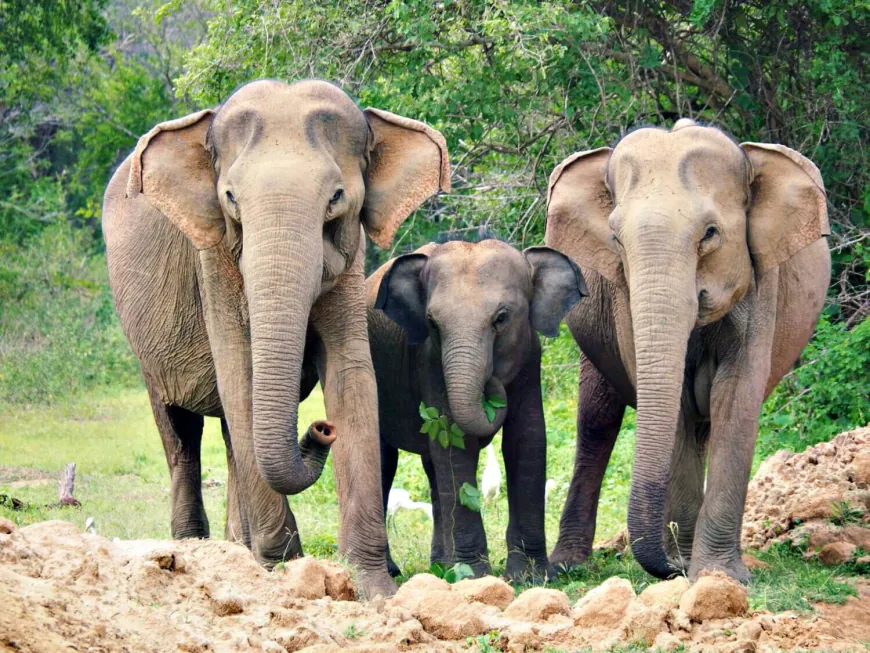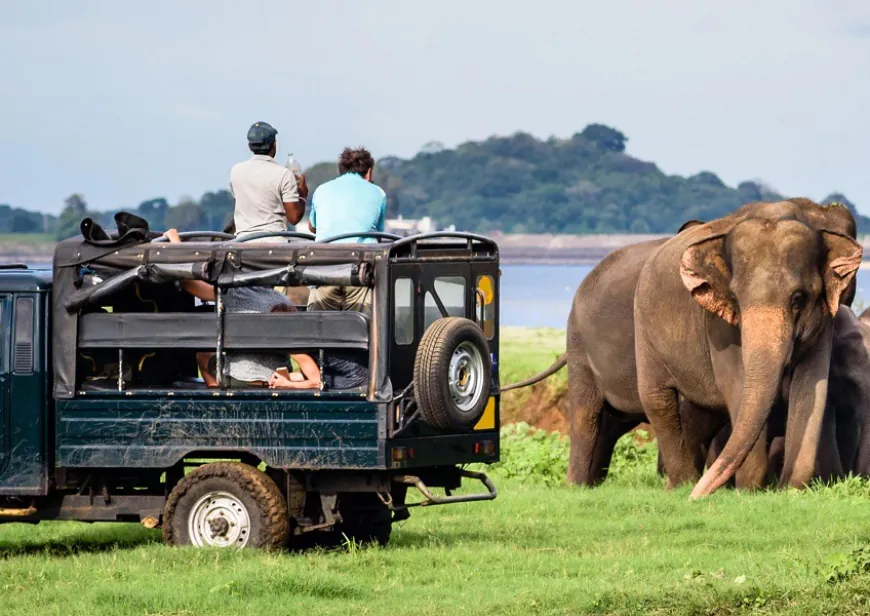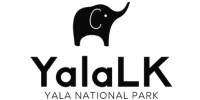Yala Safari Photography Tips
Discover expert photography tips for your Yala National Park safari. Learn best practices for capturing wildlife and essential gear recommendations for unforgettable images.

-
Introduction

Yala National Park in Sri Lanka offers a photographer's paradise, teeming with diverse wildlife and stunning landscapes that beckon to be captured through the lens. From elusive leopards to majestic elephants, mastering the art of wildlife photography in this unique setting requires patience, skill, and the right techniques to truly capture the magic of Yala's hidden gems.
-
Yala's Photographic Paradise

Yala National Park offers a diverse array of photographic opportunities, showcasing Sri Lanka's rich wildlife and stunning landscapes. Here are the key aspects that make Yala a photographer's paradise:
- Home to one of the highest leopard densities in the world, providing excellent chances to capture these elusive big cats
- Diverse ecosystems including forests, wetlands, and sand dunes spanning over 1,000 square kilometers
- 44 mammal species and 215 bird species, including Asian elephants, sloth bears, and crocodiles
- Unique coastal areas where elephants can sometimes be spotted near the shore
- Varied landscapes from dense vegetation to rocky outcrops, offering diverse backdrops for wildlife shots
Proper preparation and technique are crucial for successful wildlife photography in Yala:
- Early morning and late afternoon provide optimal lighting conditions and increased animal activity
- Patience is key - wildlife behavior is unpredictable, requiring photographers to wait for the perfect moment
- Local guides can provide invaluable knowledge about animal behavior and prime photography locations
- Respecting wildlife and park guidelines is essential for ethical photography practices
- Using appropriate equipment like telephoto lenses allows for close-up shots without disturbing animals
The challenges of wildlife photography in Yala, such as elusive subjects and unpredictable conditions, make capturing that perfect shot all the more rewarding. With proper preparation and technique, photographers can create stunning images that showcase the park's natural beauty and diverse wildlife.
-
Wildlife Photography Techniques

Understanding animal behavior and mastering technical skills are crucial for capturing stunning wildlife photographs in Yala National Park. Here's a comprehensive guide to best practices for wildlife photography:
Aspect Key Points Understanding Animal Behavior - Research species-specific behaviors before your trip - Observe animals patiently to anticipate actions - Look for tell-tale signs of impending movement or interaction - Work with experienced guides who understand local wildlife Composition Techniques - Apply the rule of thirds for balanced, engaging images - Focus on the animal's eyes to create connection - Include environmental context to tell a story - Experiment with different perspectives (eye-level, low angle) Lighting Considerations - Shoot during golden hours (1 hour after sunrise, 1 hour before sunset) for warm, soft light - Use side-lighting to add depth and texture - In harsh midday light, seek shade or use fill flash judiciously - Experiment with backlighting for dramatic silhouettes Camera Settings - Use fast shutter speeds (1/1000s or faster) for action shots - Set wider apertures (f/2.8-f/5.6) for subject isolation - Increase ISO in low light, balancing with noise considerations - Use Aperture Priority or Manual mode for more control Focusing Techniques - Utilize continuous autofocus (AI Servo) for moving subjects - Try back-button focusing for quick transitions between static and moving subjects - Use focus tracking and select appropriate AF points - Pre-focus on anticipated locations of animal activity When photographing wildlife in Yala, it's essential to adapt these techniques to the specific animals and environments you encounter. For leopards, be prepared for low-light situations in dense vegetation, requiring higher ISOs and wider apertures. When capturing elephants, consider using a wider angle to show their impressive size in the context of their surroundings.
For bird photography, which is abundant in Yala, use faster shutter speeds (1/2000s or higher) to freeze wing motion, and consider using a teleconverter for extra reach. When photographing animals near water sources, be prepared for reflections and potentially dramatic lighting conditions, especially during golden hour.
Remember that ethical wildlife photography should always prioritize the well-being of the animals. Maintain a respectful distance, avoid baiting or disturbing natural behaviors, and follow all park guidelines. By combining these technical skills with a deep respect for nature, you'll be well-equipped to capture the essence of Yala's incredible wildlife.
-
Essential Safari Photography Gear

Selecting the right gear is crucial for successful wildlife photography in Yala National Park. Here's a comprehensive guide to essential equipment for capturing stunning images on your safari:
Equipment Category Recommendations Camera Bodies - Fast autofocus system (at least 51 focus points) - High frame rate (8 fps or higher) - Good low-light performance (high ISO capabilities) - Weather-sealed body for dust protection - Full-frame for better low-light performance, crop sensor for extra reach Lenses - Telephoto zoom: 100-400mm or 150-600mm - Prime telephoto: 300mm f/2.8 or 400mm f/4 - Wide-angle zoom: 24-70mm for landscapes - Minimum aperture of f/5.6 or wider for low-light situations Support Systems - Lightweight travel tripod - Monopod for quick setup - Bean bag for vehicle window support - Window mount or clamp for added stability Accessories - Multiple high-capacity memory cards (64GB+) - Extra camera batteries and charger - Lens cleaning kit (microfiber cloths, blower) - Rain cover or waterproof camera bag - Polarizing filter for reducing glare Binoculars - 8x42 or 10x42 magnification - Wide field of view - Waterproof and fog-proof - Good low-light performance When choosing a camera body for Yala safari photography, prioritize models with fast and accurate autofocus systems to track moving wildlife. A high frame rate allows you to capture fleeting moments and animal behavior. While full-frame cameras excel in low-light conditions, crop sensor cameras can provide extra reach, which is beneficial for distant subjects.
Telephoto lenses are essential for wildlife photography in Yala National Park. A versatile zoom lens like a 100-400mm or 150-600mm offers flexibility for various subjects and distances. Prime lenses such as 300mm f/2.8 or 400mm f/4 provide superior image quality and low-light performance but at the cost of versatility.
Support systems are crucial for sharp images, especially in low light conditions. A lightweight travel tripod or monopod can provide stability when shooting from a vehicle. Bean bags are excellent for resting your camera on the vehicle window or roof.
Don't forget essential accessories like extra memory cards and batteries. Yala's dusty environment necessitates a good lens cleaning kit. A rain cover can protect your gear during unexpected showers.
Binoculars are invaluable for spotting and observing wildlife before setting up your shot. Look for models with 8x or 10x magnification and good low-light performance.
Remember, while having the right gear is important, it's your skill and creativity that will ultimately capture the magic of Yala National Park. Familiarize yourself with your equipment before the trip to make the most of every photographic opportunity.
-
Ethical Wildlife Photography Guidelines

Ethical wildlife photography is crucial for preserving the natural environment and ensuring the well-being of animals in Yala National Park. Here are key guidelines and practices for responsible wildlife photography:
Ethical Practice Guidelines Maintaining Distance - Use telephoto lenses to capture close-up shots from afar - Stay in your vehicle unless explicitly permitted otherwise - Never approach animals on foot without proper authorization Respecting Natural Behaviors - Avoid making loud noises or sudden movements that could startle animals - Do not use calls or playbacks to attract wildlife - Never feed animals to lure them closer for photos Following Park Rules - Adhere to all park regulations regarding photography - Respect off-limits areas and stick to designated routes - Do not remove any natural objects from the park Working with Guides - Listen to and follow instructions from park guides and rangers - Benefit from their knowledge of animal behavior and prime photo locations - Report any unethical behavior you witness to park authorities When photographing wildlife in Yala, it's essential to prioritize the animals' well-being over getting the "perfect shot." Maintain a safe distance that doesn't cause stress or alter natural behaviors. A good rule of thumb is if an animal changes its behavior due to your presence, you're too close.
Never attempt to provoke a reaction from animals for the sake of a photograph. This includes making noises, throwing objects, or using food as bait. Such actions can disrupt feeding patterns, mating behaviors, and even separate mothers from their young.
Yala National Park has specific guidelines for photographers. These may include restrictions on flash photography, drone usage, and entering certain areas. It's crucial to familiarize yourself with these rules before your visit and strictly adhere to them during your safari.
Park guides and rangers are invaluable resources. They possess extensive knowledge about animal behavior and can often anticipate great photo opportunities. Following their guidance not only ensures your safety but also increases your chances of capturing unique moments without disturbing the wildlife.
Remember, ethical wildlife photography goes beyond just following rules. It involves developing a deep respect for nature and understanding your role as a temporary visitor in the animals' home. By practicing ethical photography, you contribute to the conservation of Yala's diverse ecosystem and help ensure that future generations can enjoy its beauty.
-
Enhancing Wildlife Images

Post-processing is a crucial step in wildlife photography, allowing you to enhance your images while preserving their natural beauty. Here are some key tips for editing and managing your Yala safari photos:
Aspect Recommendations Basic Adjustments - Adjust exposure, contrast, and white balance to enhance overall image quality - Use selective adjustments to highlight key features (e.g. animal's eyes) - Apply noise reduction for high-ISO images - Sharpen details carefully to avoid an over-processed look Maintaining Natural Looks - Avoid oversaturating colors - Use subtle adjustments to maintain realistic fur/feather textures - Be cautious with clarity and dehaze tools to prevent an artificial appearance - Compare edited images with originals to ensure authenticity Photo Organization - Use a consistent file naming system (e.g. date_location_subject) - Apply keywords and metadata for easy searching - Create separate folders for each day or location of your safari - Use star ratings or color labels to mark your best shots Backup Strategies - Bring multiple memory cards and rotate their use - Use a portable hard drive or laptop to backup daily - Consider cloud storage if internet access is available - Keep backups in separate locations to prevent loss When adjusting wildlife photos, start with basic exposure and color corrections. Lightroom's Basic panel is excellent for this, allowing you to fine-tune highlights, shadows, and white balance. For images taken in challenging light conditions, such as early morning leopard sightings, careful adjustment of shadows and highlights can reveal hidden details.
Selective adjustments are key to enhancing wildlife portraits. Use adjustment brushes or radial filters to subtly brighten an animal's eyes or emphasize textures in fur or feathers. However, it's crucial to maintain a natural look. Avoid over-sharpening or applying too much clarity, which can make images appear artificial.
For high-ISO images, often necessary in low-light conditions like photographing nocturnal animals, apply noise reduction carefully. Balance noise reduction with detail preservation to maintain image quality. Many wildlife photographers prefer to retain some grain for a more natural look rather than applying heavy noise reduction.
Organizing your safari photos is essential given the large number of images you're likely to capture. Use a consistent file naming system and apply keywords to make searching easier later. Consider using software like Adobe Lightroom for both editing and organizing your photos. Its library module allows for efficient tagging, rating, and sorting of images.
Backing up your photos while traveling is crucial. Bring multiple memory cards and rotate their use daily. If possible, backup to a portable hard drive or laptop each evening. Some photographers even use portable backup devices designed for travel. If internet access is available, consider uploading your best shots to cloud storage for additional security.
Remember, the goal of post-processing wildlife photos is to enhance what you captured in-camera while maintaining the authenticity of the scene. Subtle adjustments that bring out the natural beauty of Yala's wildlife will result in more impactful and realistic images.
-
Mastering Yala Safari Photography

Here's a summary of key photography tips for capturing wildlife in Yala National Park:
- Understand animal behavior to anticipate and capture unique moments
- Use the golden hours (early morning and late afternoon) for optimal lighting conditions
- Employ a telephoto lens (200mm or longer) to capture close-up shots without disturbing wildlife
- Practice patience and persistence, as wildlife photography often requires waiting for the perfect moment
- Experiment with composition techniques like the rule of thirds and natural framing
- Adjust camera settings for fast shutter speeds (1/1000s or faster) to freeze action
- Use continuous autofocus and back-button focusing for tracking moving subjects
- Prioritize ethical photography practices by maintaining a respectful distance from animals
Remember that mastering wildlife photography takes time and practice. Don't get discouraged if your initial results aren't perfect. Each safari provides an opportunity to improve your skills and learn from experience.
While capturing great photos is rewarding, it's equally important to immerse yourself in the safari experience:
- Take time to observe and appreciate animal behaviors without always viewing them through a lens
- Listen to your guides, who can provide valuable insights into the park's ecosystem and wildlife
- Enjoy the sights, sounds, and atmosphere of Yala National Park beyond just photographic opportunities
- Share your experiences and favorite moments with fellow travelers, not just your best shots
By balancing your photography goals with a genuine appreciation for nature, you'll create lasting memories and potentially capture even more authentic and meaningful images of Yala's incredible wildlife.
-
Connect With Us

Stay connected with Yala National Park and enhance your wildlife experience with these engagement opportunities:
Contact us for more information about Yala safaris and photography tips:
- Email: [email protected]
- Phone: +94723456726
Join our newsletter for regular updates on:
- Wildlife sightings
- Photography tips
- Conservation efforts
- Special offers for Yala visits
Engage with our community:
- Comment on our blog posts to share your Yala experiences
- Share our articles on social media to spread awareness about Yala's wildlife
- Submit your best Yala wildlife photos for a chance to be featured on our website
- Follow us on social media platforms for daily doses of Yala's natural beauty
By staying connected, you'll not only enhance your own Yala experience but also contribute to the conservation efforts and awareness of this unique ecosystem. Your engagement helps us continue to provide valuable information and protect Yala's diverse wildlife for future generations to enjoy.
What's Your Reaction?








































